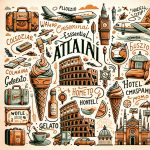Italy is a popular travel destination known for its rich history, stunning landscapes, and delicious cuisine. Whether you’re exploring the bustling streets of Rome, wandering through Renaissance art in Florence, or relaxing on the Amalfi Coast, having some knowledge of Italian phrases can greatly enhance your experience. In this article, we will explore why learning Italian phrases is essential for travelers in Italy.
One of the main reasons to learn Italian phrases is that it allows you to connect with locals on a deeper level. While many Italians speak English, especially in tourist areas, making an effort to communicate in their native language shows respect and appreciation for their culture. It also opens doors to authentic experiences, as it allows you to interact with locals who may not be fluent in English but can share valuable insights and recommendations.
Furthermore, learning basic Italian phrases helps you navigate everyday situations more smoothly. From ordering food at a trattoria or gelateria to asking for directions or buying souvenirs at local markets, being able to communicate effectively makes these experiences more enjoyable and less daunting. It also shows locals that you are willing to immerse yourself in their way of life, which often leads to warmer interactions and memorable encounters.
Lastly, learning Italian phrases adds an extra layer of safety during your travels. While Italy is generally a safe country to visit, unexpected situations can arise anywhere. Knowing essential emergency phrases can help you seek assistance promptly and alleviate any potential language barriers during critical moments.
In the following sections of this article, we will delve into specific categories of useful Italian phrases that every traveler should know when visiting Italy. From greetings and pleasantries to navigating transportation and asking for directions, we’ll provide practical examples that will empower you to make the most out of your journey through Italy’s enchanting cities and towns.
Basic Greetings and Pleasantries
Greetings
When traveling to Italy, it’s important to learn basic greetings in order to make a positive first impression and start conversations with locals. The most common way to say “hello” in Italian is “ciao,” which can be used in both formal and informal settings. Another formal way to greet someone is by saying “buongiorno,” which means “good morning” or “good day.”
This greeting is commonly used until early evening. In the evening, it is customary to switch to “buonasera,” meaning “good evening”.
Farewells
Saying goodbye is just as important as saying hello when interacting with Italians. To bid farewell, you can use the phrase “arrivederci,” which is commonly understood as “goodbye.” If you are leaving a formal setting or saying goodbye at night, you can use the phrase “buona serata,” meaning “have a good evening.” For more informal situations or when parting ways during the day, you can simply say “ciao” again.
Expressing Gratitude
Showing gratitude is an essential part of any traveler’s experience. In Italian, there are different ways to express thanks depending on the context. The most common phrase for expressing gratitude is “grazie,” which simply means “thank you.” To show even more appreciation, you can add the word “molto” before it, making it “molte grazie” or “thank you very much.” Another useful phrase that can come in handy is “ti ringrazio,” which also means “I thank you”.
By mastering these basic greetings and pleasantries, travelers will be able to navigate social situations with ease and build rapport with locals.
Navigating Transportation
When traveling in Italy, it is important to familiarize yourself with basic Italian phrases that will help you navigate transportation smoothly. Whether you are arriving at the airport, catching a train, or waiting at a bus stop, knowing how to communicate effectively in Italian can make your travel experience much easier and more enjoyable.
At airports, one of the first things you may need to do is find your way to the baggage claim area. In Italian, you can ask for directions by saying “Dov’è il ritiro bagagli?” which means “Where is the baggage claim?”. If you need assistance from airport staff, you can approach them and say “Mi scusi” or “Excuse me” followed by your question or request.
It’s also helpful to know how to ask for a taxi. To do this, you can say “Mi può chiamare un taxi, per favore?” which means “Can you call a taxi for me, please? “.
Train stations are another major transportation hub in Italy. When buying tickets at a ticket counter or machine, it’s useful to know some key phrases. You could say “Vorrei un biglietto per ” which means “I would like a ticket to “. Fill in the destination at the end of the sentence to specify where you want to go.
If you need information about train schedules or platforms, don’t hesitate to ask station staff by saying “Mi scusi, mi può dire gli orari dei treni? “/”Excuse me, can you tell me the train timetables? “.
Public buses are a common mode of transportation in Italy as well. When waiting at a bus stop and unsure about which bus to take or where it goes, simply approach someone nearby and politely ask “Scusa mi potresti dire se questo autobus va a ?” meaning “Excuse me, could you tell me if this bus goes to ?”. This way, you can ensure that you are on the right bus heading to your desired destination.
By learning these essential Italian phrases for navigating transportation, you will feel more confident and independent during your travels in Italy. The locals will also appreciate your effort to communicate with them in their native language.
Ordering Food and Beverages
When traveling to Italy, one of the highlights is undoubtedly indulging in the country’s delectable cuisine. To fully immerse yourself in the culinary delights that Italy has to offer, it is essential to learn some key Italian phrases for ordering food and beverages. Whether you are dining at a local trattoria, a charming café, or a fine dining restaurant, using these phrases will not only help you navigate the menu but also enhance your overall dining experience.
Understanding the Menu
Before diving into ordering your meal, it is important to familiarize yourself with some vocabulary commonly found on Italian menus. Typically, an Italian menu consists of different sections such as antipasti (appetizers), primi piatti (first courses), secondi piatti (second courses), contorni (side dishes), and dolci (desserts).
By knowing these terms, you can easily navigate through the menu and identify the dishes that catch your attention. Additionally, it may be helpful to learn common ingredients such as carne (meat), pesce (fish), formaggio (cheese), pomodoro (tomato), and funghi (mushrooms).
Placing Your Order
When you are ready to place your order, there are a few key phrases that will come in handy. To get the attention of your server, politely say “Scusi” (Excuse me) or “Mi scusi” (Excuse me if talking to someone senior or older). If you want to ask for recommendations or inquire about a specific dish, you can use phrases like “Cosa mi consiglia?” (What do you recommend?)
or “Mi può descrivere questo piatto?” (Can you describe this dish?). It’s also useful to know how to specify your preferences such as “senza formaggio” (without cheese) or “ben cotto” (well-done).
Interacting with the Wait Staff
Besides ordering food, it is important to be courteous and polite when interacting with wait staff. Saying “Buon appetito” (Enjoy your meal) to fellow diners or servers is a common practice in Italy. Additionally, acknowledging the service and expressing gratitude is highly appreciated.
Saying “Grazie” (Thank you) when the server brings your order or refills your glass will go a long way in establishing good rapport. It’s also worth noting that tipping is not as customary in Italy as it may be in other countries, although rounding up the bill or leaving some loose change on the table is appreciated.
By learning key Italian phrases for ordering food and beverages, you can confidently navigate Italian menus, interact with wait staff, and fully immerse yourself in the culinary delights of Italy. Remember to embrace the local customs and enjoy the dining experience to its fullest extent.
Asking for Directions
In a foreign country like Italy, navigating the streets and finding your way around can be a bit daunting, especially if you don’t speak the language. However, with a few key Italian phrases in your arsenal, asking for directions can become much easier. Here are some essential Italian phrases that will help you find your way around Italian cities and towns:
- “Scusi, dov’è la stazione?” – This phrase translates to “Excuse me, where is the train station?” It’s a useful question to ask when you need to catch a train or find your way back to the station.
- “Mi può dire come arrivare al Colosseo?” – This means “Can you tell me how to get to the Colosseum?” It’s perfect for tourists planning to explore Rome’s iconic landmark.
- “C’è un ristorante buono qui vicino?” – If you’re feeling hungry and need recommendations for nearby restaurants, this phrase will come in handy. It means “Is there a good restaurant nearby?”
Additionally, it’s important to know how to understand directions given by locals. Here are some phrases that will help you comprehend their instructions:
- “A destra” – This means “to the right.” You’ll often hear this phrase when someone tells you which direction to turn.
- “A sinistra” – On the flip side, this means “to the left.” Remembering these two phrases will prevent confusion when following directions.
- “Dritto” – When someone tells you to go straight ahead, they’re using this word. Keep an eye out for road signs confirming that you’re going in the right direction.
By familiarizing yourself with these common phrases and understanding basic directions, you’ll be better equipped to navigate Italian streets confidently and effortlessly. Asking for directions in Italian also shows locals that you’re making an effort to communicate in their language, which often leads to a more pleasant and helpful interaction.
Shopping and Bargaining
In Italy, shopping and bargaining are not just a way to purchase goods; they are a cultural experience. Italian markets are known for their vibrant atmosphere and unique products, and knowing how to communicate with shopkeepers is essential for navigating these bustling shopping destinations. By learning key Italian phrases, travelers can not only secure the best deals but also connect with locals and immerse themselves in the Italian lifestyle.
When entering a shop or market stall, it is polite to greet the shopkeeper with a friendly “Buongiorno” (good morning) or “Buonasera” (good evening). Building rapport through small talk is an important part of the shopping experience in Italy. You can use phrases like “Come va?” (How are you?), “Che bel posto.” (What a beautiful place.), or “Mi piace molto” (I really like it) to show your appreciation for the store or market.
Once you have found something you like, it’s time to negotiate the price. Bargaining is customary in many Italian markets, especially those selling art, antiques, clothing, and accessories. To ask for a discount, you can say “Posso avere uno sconto?” (Can I have a discount?) or “Può farmi uno sconto?” (Can you give me a discount?). It’s important to maintain a respectful and friendly tone during negotiations.
| Italian Phrase | English Translation |
|---|---|
| Quanto costa? | How much does it cost? |
| Troppo caro/a. | Too expensive. |
| Può farmi uno sconto? | Can you give me a discount? |
| Vorrei provare questo, per favore. | I would like to try this, please. |
| Negotiating price: | “Un po’ di meno?” (A bit less?), “E se lo prendo due?” (What if I buy two?), “Riesce a fare uno sconto migliore?” (Can you offer a better discount?) |
Emergency Situations
During your travels in Italy, it’s important to be prepared for unexpected situations or emergencies that may arise. While we hope that you won’t encounter any difficult situations, it’s always better to be safe than sorry. This section will provide you with some essential Italian phrases to help you stay safe and seek help if needed.
In emergency situations, communication becomes even more crucial. It’s important to know how to ask for help or convey your needs clearly and concisely. Here are some Italian phrases that will come in handy if you find yourself in an emergency:
- “Aiuto.” – This means “Help.” in Italian. Use this exclamation if you need immediate assistance.
- “Chiamate un’ambulanza.” – If you require medical assistance, saying “Call an ambulance.” will prompt someone nearby to call for help.
- “Ho perso i miei documenti” – If you lose your documents such as your passport or ID, use this phrase to inform the authorities of the situation.
- “Dove posso trovare un ospedale?” – This translates to “Where can I find a hospital?” It’s crucial to know how to ask for directions to a hospital in case of a medical emergency.
- “La mia borsa è stata rubata” – If your bag has been stolen, use this phrase to report the incident and file a police report.
Remember that being calm and polite during emergencies is essential. Additionally, having important information such as the address of your accommodation or local emergency numbers stored on your phone can also be helpful in times of crisis.
By familiarizing yourself with these key Italian phrases for emergency situations, you’ll have a better chance of staying safe and seeking help effectively during unexpected circumstances while traveling in Italy.
Cultural Etiquette
Italy is a country rich in culture and tradition, and it is important for travelers to understand Italian customs and use polite phrases to show respect. Italians value politeness and good manners, so knowing the appropriate phrases can enhance your travel experience and help you make a positive impression.
In Italy, greetings are an essential part of everyday interactions. When meeting someone for the first time, it is customary to shake hands and make eye contact. Italians also greet each other with a kiss on both cheeks, but this is usually reserved for friends and family members. Saying “buongiorno” (good morning) or “buonasera” (good evening) when entering a shop or restaurant shows that you are respectful and polite.
Italians take meal times seriously, and there are certain customs to be aware of when dining out. It is common for Italians to linger over their meals, so don’t rush through your food. When entering a restaurant, it is polite to greet the staff with a friendly “buonasera” or “salve.” At the end of your meal, saying “grazie mille” (thank you very much) to your waiter or waitress shows appreciation for their service.
Part of understanding Italian customs includes being aware of appropriate dress etiquette. When visiting churches or religious sites, it is important to cover your shoulders and knees as a sign of respect. Wearing modest clothing is also expected if you plan on visiting more conservative areas outside major cities. To show respect when entering someone’s home or a place of worship, saying “permesso” (may I come in) as you enter can demonstrate your awareness of Italian customs.
By understanding and embracing Italian customs, you can navigate cultural situations with ease during your travels in Italy. Using polite phrases such as greetings and expressions of gratitude will not only show respect but also help you connect with locals on a deeper level. Being mindful of dress codes and following social customs will ensure a positive and memorable travel experience in this beautiful country.
Romantic Phrases
Whether you’re traveling with a partner or hoping to meet someone special during your time in Italy, learning some romantic phrases in Italian can go a long way in impressing the locals and making your experience even more memorable. Italians are known for their passion and romance, so being able to express yourself in their native language can help you connect on a deeper level.
To start, it’s important to learn the basic terms of endearment. “Amore” is the most common way to say “love” in Italian, but there are many other options as well. “Tesoro” means “treasure,” and can be used to refer to your loved one.
“Bello/bella” means “beautiful” and can be used as a general compliment or directed at someone you’re attracted to. “Tesoro mio” or “amore mio” translate to “my treasure” or “my love,” respectively, and are often used as affectionate nicknames.
If you want to express your feelings more deeply, you can use phrases such as “Ti amo,” which means “I love you.” Keep in mind that this phrase is quite serious and should only be used when you truly mean it. If you’re not ready for such a strong declaration just yet, saying “Mi piaci molto,” which means “I really like you,” is a great alternative.
Romantic settings often call for poetic expressions. Try saying things like “Sei la mia anima gemella” (You are my soulmate) or “Senza di te non posso vivere” (I cannot live without you). These heartfelt phrases are sure to make your partner feel special and loved.
Learning these romantic phrases will not only impress the locals but also enhance your travel experience by allowing you to fully immerse yourself in the Italian culture of love and romance. So why not give it a try? Let the language of love guide you through your journey in Italy.
Conclusion
In conclusion, learning Italian phrases is essential for travelers in Italy. By mastering basic greetings and pleasantries, navigating transportation, ordering food and beverages, asking for directions, shopping and bargaining, handling emergency situations, understanding cultural etiquette, and using romantic expressions, you can enhance your travel experience in Italy.
When you learn Italian phrases for greetings and pleasantries, you are not only showing respect to the locals but also creating a positive atmosphere wherever you go. By saying “hello,” “goodbye,” and “thank you” in Italian, you can make meaningful connections with the people you meet along your journey.
Navigating transportation becomes much easier when you have a grasp of essential Italian phrases. Whether it’s at airports, train stations, or bus stops, being able to communicate effectively will help ensure that your travel plans run smoothly.
Ordering food and beverages should be a delightful experience during your travels in Italy. Learning key Italian phrases like how to order dishes and express preferences will not only make dining experiences more enjoyable but also open doors to discovering new local flavors.
Asking for directions while exploring Italian cities and towns can be challenging if you don’t speak the language. By familiarizing yourself with useful Italian phrases for asking directions, you’ll be able to navigate through unfamiliar places with confidence.
When shopping or bargaining at markets in Italy, knowing how to communicate with shopkeepers is crucial. Using key Italian phrases will not only enable smoother transactions but may also help secure the best deals.
In case unexpected circumstances arise during your trip to Italy, it’s important to know how to seek help and stay safe. Understanding important Italian phrases for emergencies will give you peace of mind and assist you in getting the assistance needed promptly.
Understanding cultural etiquette is vital when traveling abroad. Using polite Italian phrases shows respect towards locals and their customs. It allows travelers to immerse themselves more fully into the rich cultural heritage of Italy.
Finally, learning romantic expressions in Italian can add a touch of charm to your travels. Impress locals and woo your partner by using these delightful phrases, creating memorable experiences that go beyond the usual tourist activities.

I’m a passionate traveler, writer, and Italophile. My fascination with Italy’s history, art, and culture has led me on countless adventures across the Italian landscape. Through “I Live Italy,” I share my love for this extraordinary country and aims to inspire others to explore its boundless beauty.





